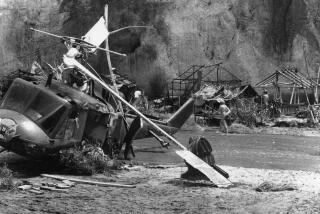Stuntwoman’s Family Sues Over Fatal 42-Foot Fall on Set : Courts: Mother seeks $10 million, saying studio did not provide proper safety equipment. Defendants have made no comment.
Wanda Sapp often visited movie sets to watch her daughter perform stunts. She never dreamed she’d watch her daughter die.
Sapp and two of her other children were present in November, when Sonja Davis fell to her death while working as a stunt double on the upcoming Eddie Murphy film “Vampire in Brooklyn.” The family is suing Paramount Studios and Eddie Murphy Productions for $10 million, alleging that the film crew failed to provide proper safety equipment.
“The last words I heard my baby say was when she yelled down to the stunt coordinator, ‘Are you sure?’ ” Sapp sobbed during a telephone interview from her home in Fontana this week. “I could feel Sonja wasn’t comfortable with the stunt.”
Sapp said she sat stunned and unable to leave her seat on the set during the 42-foot backward fall off a building. The air bag that was to cushion Davis’ fall instead reacted like a huge balloon, causing the young woman to bounce, slam into the building and hit the ground, Sapp said. Davis’ brother, Patrick, was also on the set and videotaped his sister’s fatal fall.
A Paramount Studios representative said Thursday that the company had no comment and officials at Eddie Murphy Productions could not be reached.
Sapp and her three remaining children have filed a wrongful death suit alleging that the studio, the production company, director Wes Craven, and stunt coordinator Alan Oliney recklessly and with gross negligence instructed Davis to jump without a safety line, and rented an air bag that was improperly placed.
According to her mother, Davis, who lingered in a coma for 13 days with multiple injuries before she died, was nervous about the stunt and had wanted to do the jump face-forward.
“She asked them three times (as she stood on top of the building before the stunt) if they were sure it was OK,” Sapp said. “I could feel her lack of confidence and then she paused.”
As one of only a handful of African American stuntwomen, Davis, 32, worked consistently. She served as stunt double for such female stars as Janet Jackson, Whoopi Goldberg and Angela Bassett--the actress for whom she was working as a stunt double at the time of her death.
Davis was an aerobics instructor and nutritionist five years ago when she met a group of stuntmen who invited her to attend their rehearsals. An avid sportswoman, she quickly fell in love with the fast-paced, high-risk action of stunt work.
“Sonja enjoyed what she did,” Sapp said about the second-eldest of her four children. “So many people came up to me at the funeral to tell me how good she was.”
As a stuntwoman, Davis entered an almost cloistered group of men and women who often face death. Her mother said she did it all--jumps, fight scenes, motorcycle and auto stunts--and enjoyed the camaraderie that accompanied the specialized profession. Stuntmen and stuntwomen often help train one another, and Davis made many friends in the business who were willing to guide her and teach her the tricks of the trade.
Bob Minor, a stuntman who has been in the business for 25 years, said Davis was pretty green when he began to help her five years ago. He said she quickly moved up through the ranks to distinguish herself.
“I considered her the top black female stuntperson in the business,” said Minor, who as a stunt coordinator had hired Davis to work on “Poetic Justice” and other films. “She is already being missed in the business.”
Minor refused to comment on the accident because he had not been on the set when it occurred, but said stunt work is not as dangerous as people envision because professionals train and “the percentages are more often with us than against us.”
Other colleagues hesitated to discuss Davis and her career.
According to Minor, stunt work requires athletic ability, coordination and the ability to listen and take direction well, all attributes he said Davis had.
“She was very much a professional,” he said.
Sapp remembered her daughter as a young woman who had strong religious faith and was close to her older sister, Tanya, and younger brothers, Sazon and Patrick. The family often prayed together and Sapp said she quickly prayed with her daughter before she rushed off to film the fatal scene.
Davis’ mother said she tried to get her daughter to carry a St. Jude medal with her on the jump but she refused. “She said ‘Momma, I don’t need it because I have the Lord in my heart,’ ” Sapp said tearfully.
The California Occupational Safety and Health Administration is investigating the stuntwoman’s death and Paramount’s filming permit for the day of the jump noted pushing a “dummy from building onto parked car.” There was no mention of Davis’ jump.
“People love to go to the movies and be thrilled by what these people do without realizing how meticulous they have to be,” said attorney Melvin Belli, whose firm is representing the family. “Sonja was meticulous and that’s what made her one of the best in the business.”
Belli said the air bag had been moved from the position Davis approved for the jump.
Bassett, who worked with Davis on three movies, including “What’s Love Got to Do With It,” released a statement through her publicist.
“She was a dedicated artist,” Bassett’s statement said. “Her work was extremely important to her but first and foremost she was a woman of God and I love and miss her dearly.”
Sapp said she is not really concerned with any money she may be awarded if she wins the lawsuit. She has another mission.
“I hope that this is something that will make the industry think about these people that do death-defying stunts and think about their safety,” she said.
More to Read
The biggest entertainment stories
Get our big stories about Hollywood, film, television, music, arts, culture and more right in your inbox as soon as they publish.
You may occasionally receive promotional content from the Los Angeles Times.










